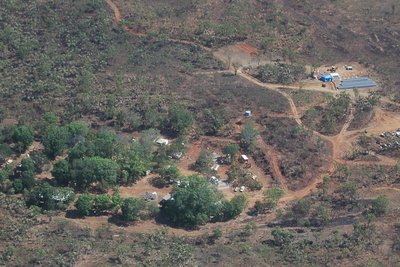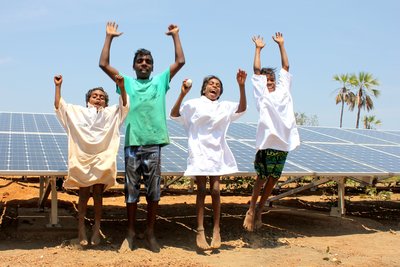Aboriginal community powered by the sun
In early September 2012, Solarmatrix personnel went on a 6400 km round trip journey through Western Australia to install a 38 kW standalone solar power system in the Kandiwal Aboriginal Community, deep in the heart of the Kimberley. The community is situated in such a remote area that supplies for the installation team had to be brought in, including kitchen utensils, fridges, camping gear and camp showers.
The Kandiwal Community is home to about 40 people, half of whom are children. The Kandiwal elders working with the Mitchell Plateau Association charity commissioned the project for the future development of the community. The solar power system will power the whole community and a newly planned school. The school is an important pillar of the development strategy and will provide education for the children and training for the young people and adults to be employed in local tourism services.
Before the installation of the solar power system, the community was dependent on a diesel generator to supplement the existing solar array. Diesel generators funded by the government are expensive to run, have a high fuel use, require frequent maintenance and pollute the environment. Furthermore, the community had a solar power system installed by the government in 2006 which worked well but was too small for their growing demand.
The Solarmatrix installation team, comprising seven men, commenced work on 13 September laying heavy three‐phase cable from the solar power system to the community. Despite setbacks caused by an enormous willy‐willy raging through the installation site, the installation was completed in two weeks. Works included installing all 152 solar panels and the cyclone-rated mounting frame, building a dedicated shed for the 144 batteries, wiring and mounting of all inverters in a retired 6 m sea container, connecting the system to the existing diesel generator and the community, as well as doing part of the trenching for the cable runs in the community.

“The trenching through rocky ground in the 41°C heat and the long cable runs were the most physically challenging parts of the whole project,” said Durmus Yildiz, managing director of Solarmatrix.
The three‐phase, AC-coupled solar power system with battery and diesel backup will offer the community the freedom to power the planned school, as well as a new coolroom, in addition to their current load. The diesel generator serves solely as a backup and will only be needed in the unlikely event of component failure. Renewable energy generation will meet 100% of the community’s load day and night over the whole year.

State-of-the-art equipment allows simple system expansion in the future should the community grow further than anticipated. Yildiz explains, “This is a crucial advantage since ordinary off‐grid systems often don’t easily allow for modifications and expansions.”
The solar panels are 250 W monocrystalline panels made by SolarWorld. Nine of the remote-power SMA Sunny Island inverters are connected in three main clusters to deliver a reliable three-phase output. On the DC to AC conversion side, the system comprises four highly efficient Sunny Tripower inverters. The batteries, from Sonnenschein, will have a design life of 10 years and a storage capacity of 450 kWh at 80% depth of discharge. Sonnenschein batteries are sealed and thus do not require any costly maintenance, bar the regular visual check and voltage measurements to ensure their charging rhythm is correct.

Off‐grid solar power systems in remote locations are a good alternative to diesel-powered generation. In addition to the environmental benefit and noise reduction, they deliver a huge cost saving and require very little maintenance.
Fluoride boosts water-processed perovskite solar cells
Queensland University of Technology has developed a water processing method to fabricate more...
Multibuild solar installation delivered at City of Playford
Trinasolar partnered with Venergy Solar to deliver a multibuild solar installation across the...
Oracle assists major distributor in clean energy transition
Essential Energy, an electricity distributor in Australia, is said to have modernised its...










